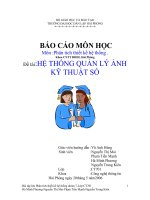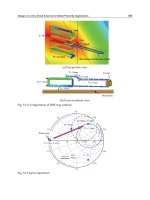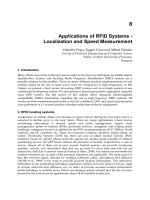Identification mineral 7
Bạn đang xem bản rút gọn của tài liệu. Xem và tải ngay bản đầy đủ của tài liệu tại đây (1.48 MB, 28 trang )
The Trace Minerals
Objectives
• After reading Chapter 7 and
class discussion, you will be
able to:
–
–
–
–
Identify trace minerals
Define trace minerals
Define hemoglobin and myoglobin
Describe heme and nonheme iron and its
absorption
Objectives
• Identify food sources of iron
• Identify those at high risk for
iron deficiency
• Identify recommendation for
daily iron intake
• Describe iron toxicity symptoms
The Trace Minerals
The Trace Minerals
• Other Trace Minerals
– Chromium
– Molybdenum
– Manganese
-Selenium
-Nickel
-Silicon
• IRON
–
–
–
–
–
Functions
Absorption
Deficiency/Toxicity
Recommendations
Food sources
-Fluoride
-Copper
-Cobalt
Iron: Functions
• Part of the protein hemoglobin,
which carries oxygen in the blood
• Part of the protein myoglobin in
muscles, which makes oxygen
available for muscle contraction
• Necessary for the utilization of
energy as part of the cells’
metabolic machinery
Iron Absorption
Iron: Heme vs. Nonheme
Factors Enhancing
Nonheme Iron Absorption
• MFP factor
• Vitamin C
• Citric acid from
foods & stomach
• Lactic acid from
foods
• HCl from stomach
• Sugars (including
wine)
Factors Inhibiting
Nonheme Iron Absorption
• Phytates – soy products
• Fibers – whole grains, nuts
• Oxalates – spinach, beets, rhubarb
• Calcium
• Phosphorus
• EDTA (food additive, preservative)
• Tanic acid – tea, coffee
Iron Deficiency
• High risk for iron deficiency
–Women in reproductive years
–Pregnant women
–Infants and young children
–Teenagers
–Blood loss
Iron Deficiency
• How is Fe deficiency measured?
• How does Fe deficiency develop?
• Stages of iron deficiency
– Iron stores diminish
– Transport iron decreases
– Hemoglobin production declines
Deficiency Symptoms
Anemia: weakness, fatigue,
headaches
Impaired work performance and
cognitive function
Impaired immunity
Pale skin, nailbeds, mucous
membranes, and palm creases
Concave nails
Inability to regulate body
temperature
Pica
Toxicity Symptoms
• GI distress
• Iron overload: infections,
fatigue, joint pain, skin
pigmentation, organ damage
Recommendations
• 2001 RDA
– Men: 8 mg/day
– Women (19-50 years): 18 mg/day
– Women (51+ years): 8 mg/day
• Upper level for adults: 45
mg/day
Iron: Food Sources
• Significant sources
– Red meats, fish, poultry, shellfish, eggs
– Legumes, dried fruits
– Enrichment
Non-Food Sources of
Iron
• Contamination
iron from iron
cookware
– More acidic the
food
– Longer cooking
time
– Fe content of
eggs can triple
– Poorly absorbed
• 1-2%
absorbed
Iron Supplements
• Form
– Ferrous sulfate or iron chelate
– Less well absorbed so doses high
• Take between meals or
bedtime
• Take on empty stomach
• Take with liquids
– Not milk, tea, coffee
• Take as a single dose
More On Supplements
• No benefit to taking
supplements with orange juice
(Vitamin C)
– Vitamin C converts insoluble ferric iron in
foods to more soluble form of ferrous iron
• Constipation a common side
effect of iron supplementation
– Increase water intake
– Is there a negative impact to increasing
fiber intake?
Objectives
• After reading Chapter 7 and
class discussion, you will be
able to:
–
–
–
–
Identify trace minerals
Define trace minerals
Define hemoglobin and myoglobin
Describe heme and nonheme iron and its
absorption
Objectives
• Identify food sources of iron
• Identify those at high risk for
iron deficiency
• Estimate recommendation for
daily iron intake
• Describe iron toxicity symptoms









